
- Details
- Written by: Jessica Webster
- Category: News
- Hits: 571

Peter Mac researcher Dr James Buteau was awarded an Australian and New Zealand Urogenital and Prostate (ANZUP) Below the Belt Research Award this week for an innovative project using artificial intelligence (AI).
Dr Buteau’s new project will use AI to create a one-click solution for prostate cancer segmentation on PET scans. Currently, specialised and expensive software is needed to measure the PET biomarkers with most medical centres needing to use a time-consuming manual contouring process that can give different results between users. This limits routine use of the PET biomarkers in most hospitals.
Dr Buteau, who received his award at the ANZUP Annual Scientific Meeting, will use this grant to build on his landmark ANZUP TheraP (ANZUP 1603) randomised controlled trial of Lutetium-177-PSMA that improves outcomes for patients with metastatic castration-resistant prostate cancer.
This form of liquid radiation is injected into a vein, goes into prostate cancer cells and delivers highly targeted radiation, while giving little radiation to normal organs.
“I am very proud and excited to have received this grant on behalf of a brilliant team,” Dr Buteau said.
“This new project will utilise AI to create and validate a single-click solution to measure the PET biomarkers.
“It’s an innovative approach that could improve access worldwide and measure accurate PET biomarker values regardless of a centre’s expertise or location.”
The project, under Prof Michael Hofman’s supervision and in collaboration with Peter Mac medical physicists Dr Price Jackson and Lachlan McIntosh, addresses a limitation from Dr Buteau’s TheraP biomarker analysis that was published in Lancet Oncology last year.
Together with lead investigators Professor Hofman, Professor Andrew Martin, Professor Ian Davis and the TheraP team, their biomarker analysis demonstrated, for the first time, that high tumour uptake on the PSMA PET scan is a predictive biomarker for response to Lutetium-177-PSMA. They also demonstrated FDG PET is a prognostic biomarker.
“The PET scans are like a window into the future, done before giving the Lutetium-177-PSMA,” Dr Buteau said.
“PSMA PET scans help us identify patients with exquisitely high chances of responding specifically to Lutetium-177-PSMA.
“The FDG PET scan is also a tool that can help find patients who would have worse outcomes and may need treatment intensification, such as a combination of Lutetium-177-PSMA with another active therapy.”
The Below the Belt Research Fund provides much needed seed funding to support ANZUP members to progress new trial ideas to the point of becoming full scale studies.

- Details
- Written by: Christopher Talbot
- Category: News
- Hits: 996

Metro Tunnel works for the new Parkville Station are moving into the final phase of construction and there are some changes to Grattan Street starting on Tuesday July 11.
You will still be able to walk around the Peter Mac building, but there are several traffic changes which will affect the patient drop-off zone on Grattan Street.
- The current turning circle on Grattan Street will be closed.
- The short-term drop-off zone on Grattan Street outside Peter Mac will be closed and alternative arrangements are being put in place for patient drop-off/pick-up.
Patient drop-off options
- The Peter Mac carpark is free for patient drop-off for the first 30 minutes. Take a ticket and drive in, drop the patient on level B3 near the lifts and then exit the carpark. Exit using the same ticket (don’t take it to a pay station).
- Patients can still be dropped off or picked up outside the Royal Melbourne Hospital – there is a pedestrian access path to cross the road to Peter Mac. Taxis are also available here.
- There is a small patient drop-off zone on Elizabeth Street with enough space for two vehicles (turn left from Flemington Road to access this drop off point).
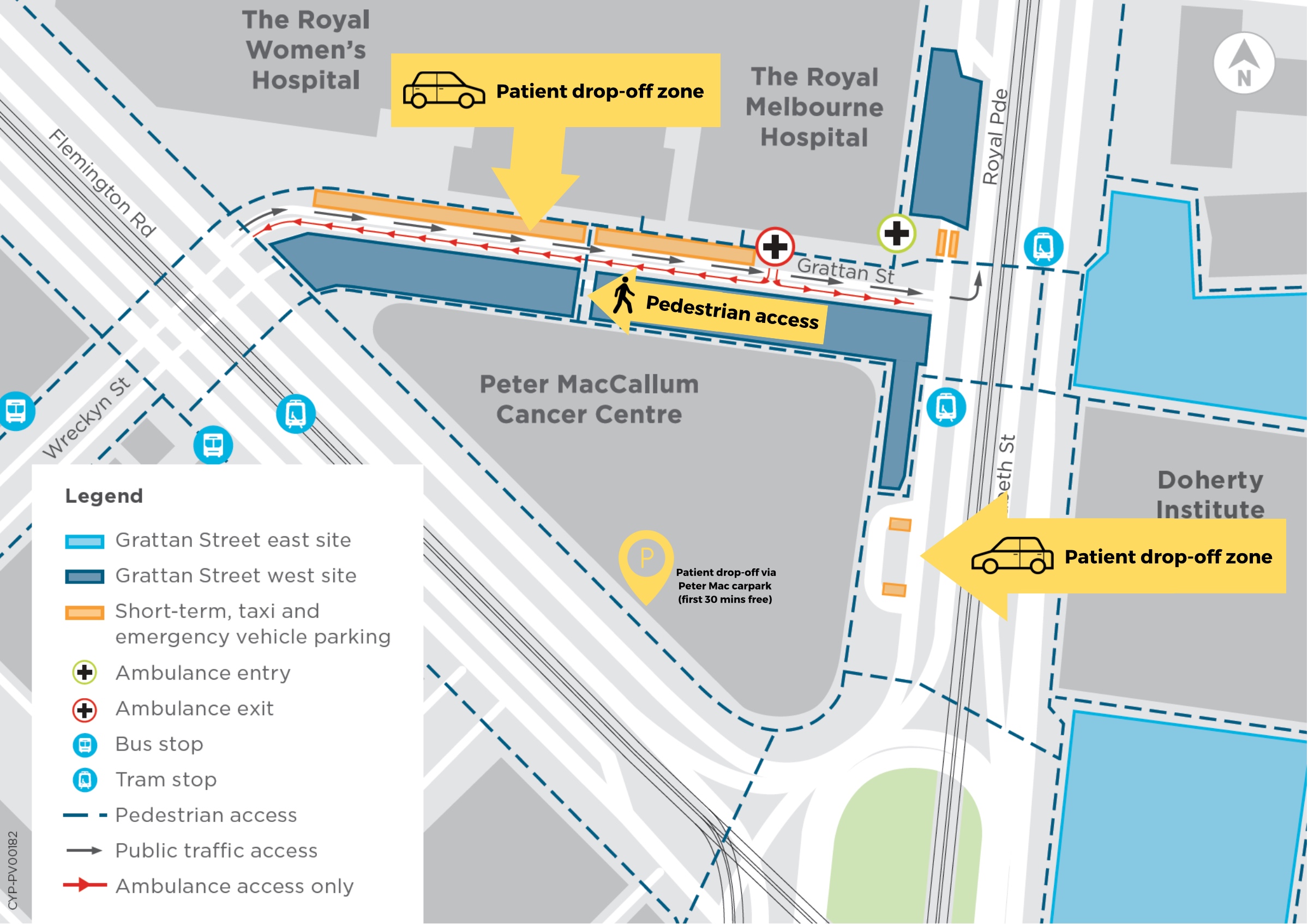
Related pages

- Details
- Written by: Mandi Robertson
- Category: News
- Hits: 746
Professor Mark Dawson, Head of Cancer Epigenetics Laboratory at Peter Mac has been awarded a Translational Research Program (TRP) grant worth USD $750,000 to further his research to help overcome acquired resistance to anti-cancer cellular immunotherapies, such as CAR T-cell therapy.
The prestigious TRP grant is an international collaboration with funding from the US Leukemia & Lymphoma Society (LLS), Snowdome Foundation and the Leukaemia Foundation. The grant is designed to fund innovative research projects that propose novel approaches to the prevention, diagnosis, or treatment of blood cancers and which show high promise for translating basic biomedical knowledge to clinical application.

Professor Dawson said this team has developed cutting-edge, pre-clinical models that simulate resistance to CAR T-cell therapy.
“By harnessing the power of the models, we aim to uncover the intrinsic properties of cancer cells that enable them to evade new cellular therapies, paving the way for the design and development of novel therapeutic approaches,” he said.
“We are thrilled for Professor Dawson, whose submission has been internationally recognised as one of the top global blood cancer research projects of 2023,” said Snowdome Foundation Chief Executive, Kirstee Macbeth.
“His research investigating immune evasion of CAR T-cells, has the potential to further enhance the effectiveness of immunotherapy, now recognised as a key pillar of cancer treatment and one that can benefit Australian blood cancer patients.”
More than 135,000 Australians are living with a blood cancer, myeloma, leukaemia or lymphoma today and the incidence is rising. The research conducted by Professor Dawson and his team will hopefully help find a cure.
If you would like to donate to fund more research please visit the Peter Mac Foundation.
Related pages
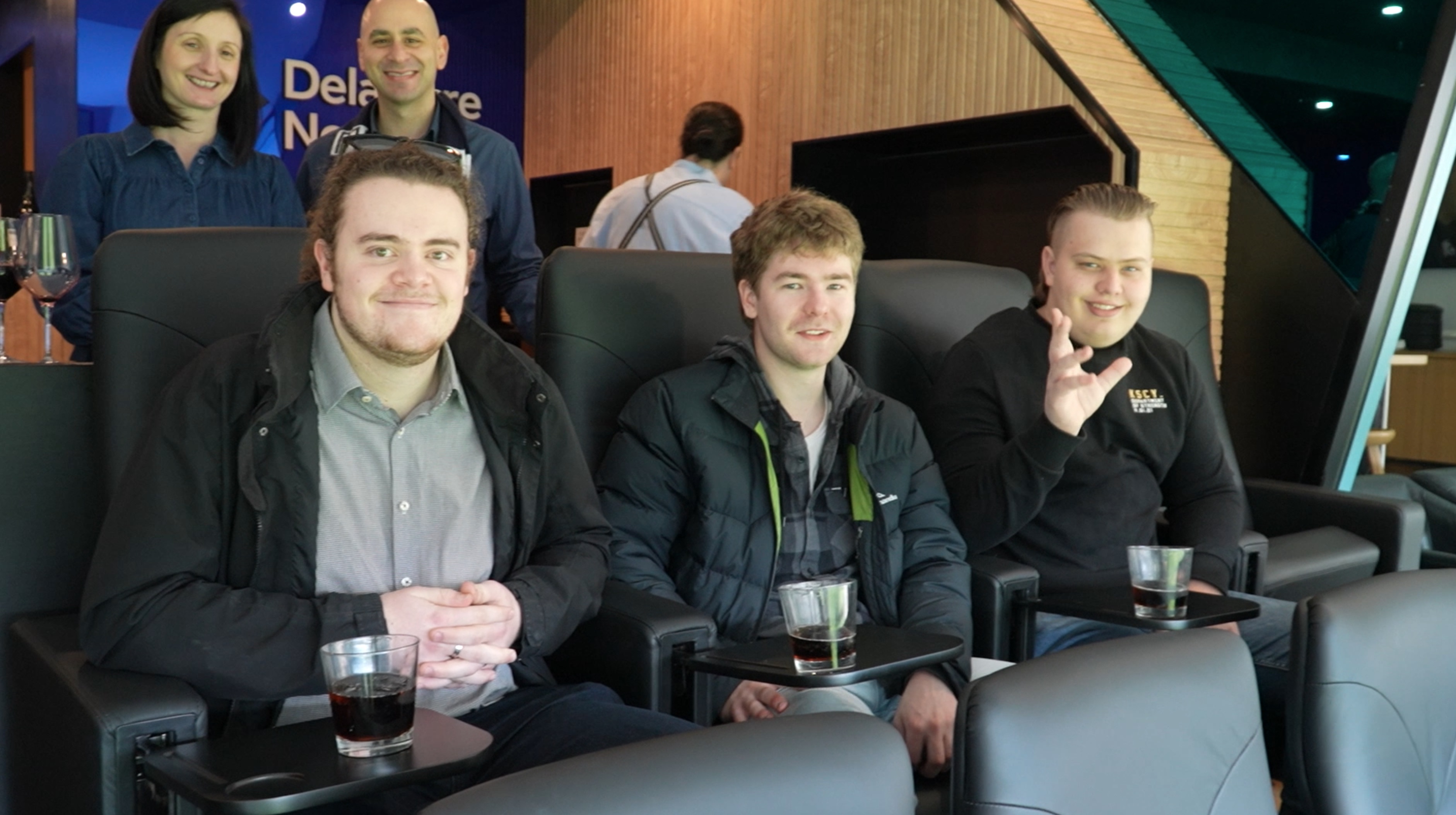
- Details
- Written by: Christopher Talbot
- Category: News
- Hits: 306
Carlton Football Club generously provided a private box and invited Peter Mac patients and their families to attend the footy at the MCG recently.
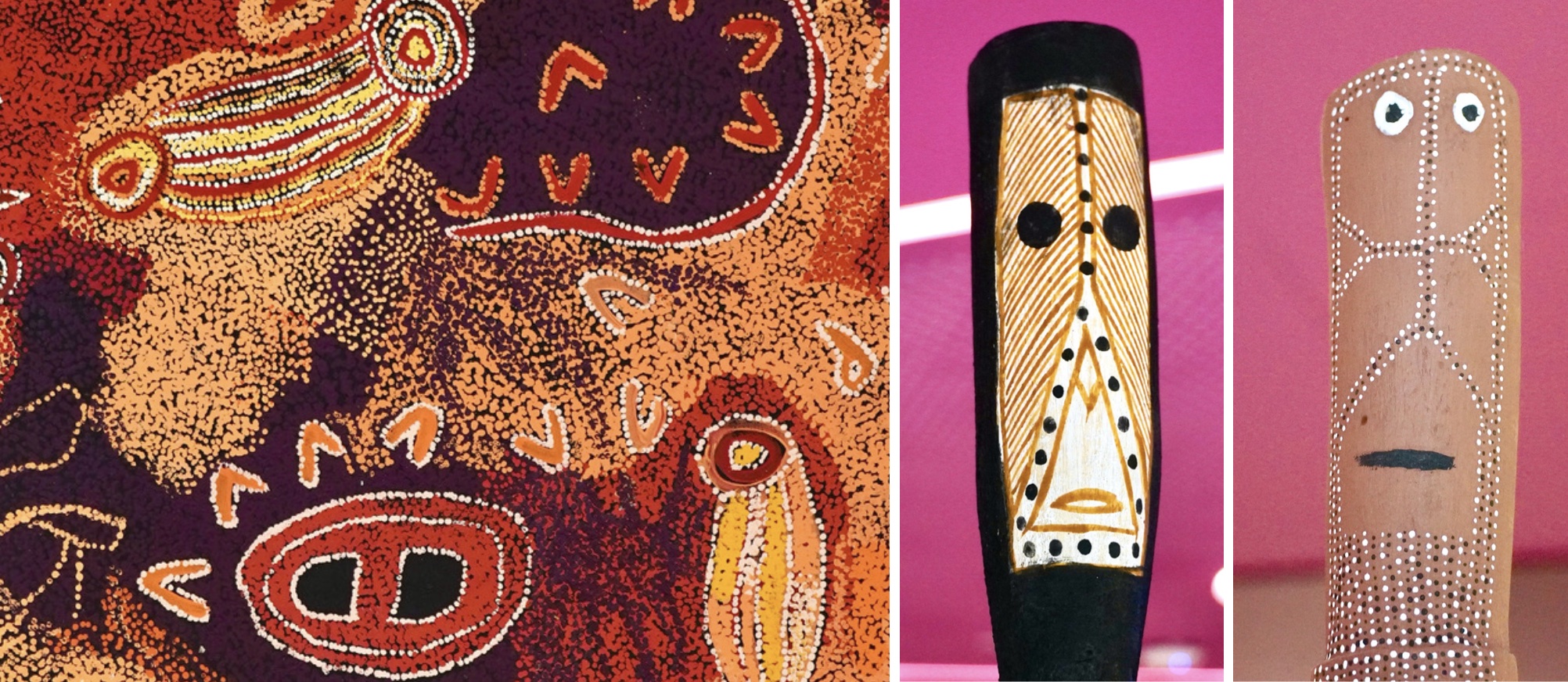
- Details
- Written by: Christopher Talbot
- Category: News
- Hits: 600
In celebration of NAIDOC Week, we’ve added three stunning new paintings and three sculptures to Peter Mac’s Aboriginal art collection.
NAIDOC is all about recognising the history, culture and achievements of the oldest, continuous living culture on earth.
Art is a huge part of that as it carries stories, traditions and spiritual significance - ensuring that future generations can learn about and appreciate the artistic and cultural traditions of First Nations peoples.
Peter Mac has an extensive collection from First Nations artists which not only inject colour into the building but is a visual reminder of the enduring presence and resilience of Aboriginal and Torres Strait Islander people.
We’re incredibly excited to unveil six significant new works to the collection, all generously donated through the Australian Government’s Cultural Gifts Program.
Check out photos of the new works and read about the artists below.
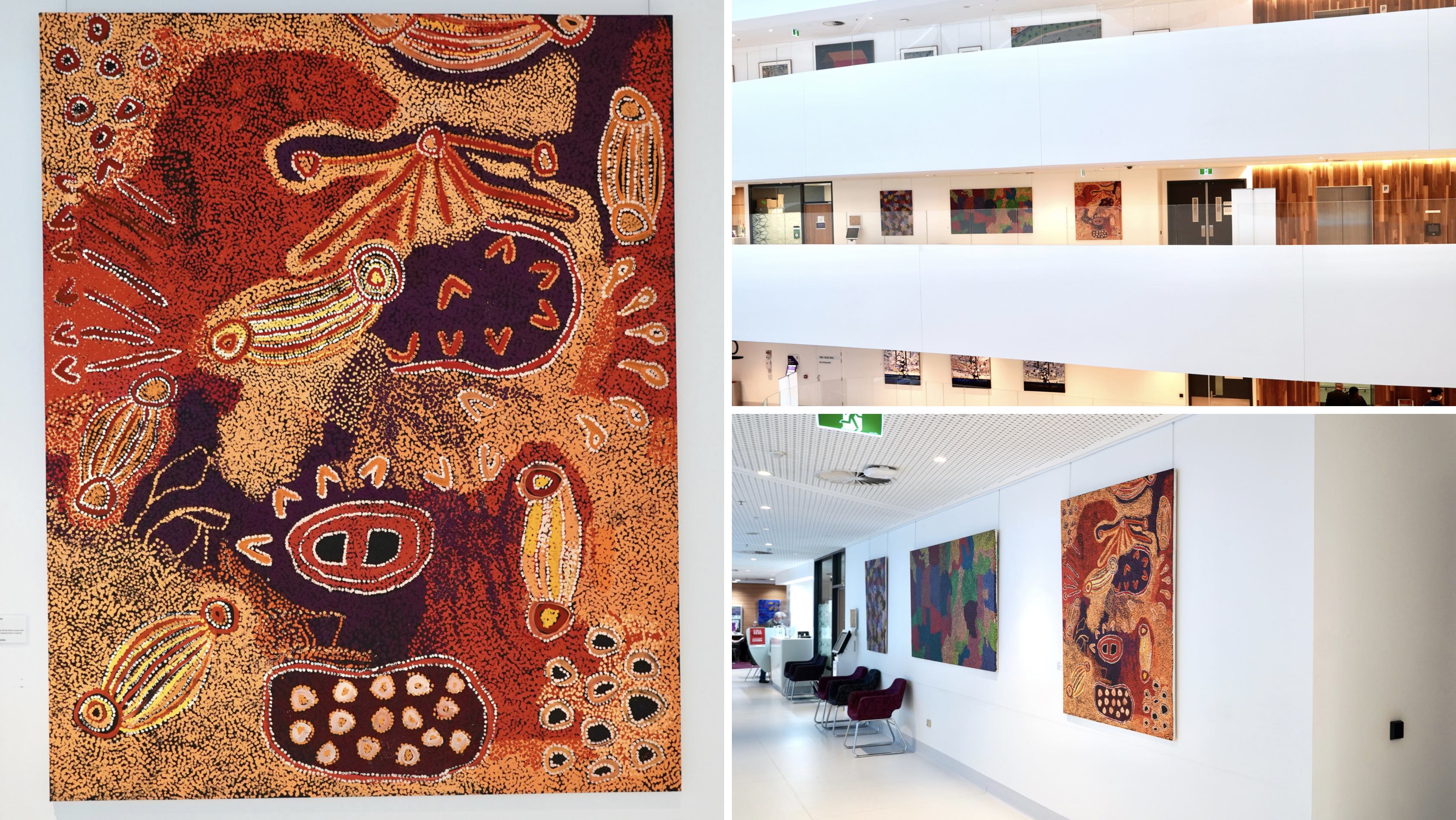
Kulu Alu (2013) by Sallyanne Roberts
Location: Level 3 near clinic 3C.
Sallyanne Roberts began painting at the Tjungu Palya art centre in the small community of Nyapari, deep in the Pitjantatjara desert, the very heart of the APY lands. One of a new generation of painters from this area, she was nurtured and encouraged by her grandmother Kunmanara (Wingu) Tingma, a senior law woman, traditional healer and celebrated painter.
As Sallyanne has said of her grandmother”….when she was getting very old, she taught me her stories and how to paint them in our special family’s way. She taught me how to paint the pictures of Kuru Ala country, it’s a special place just for women”
Kuru Ala is a sacred place for the Kungkarrakalpa (Seven Sisters Creation Story), a space for special “inma” (ceremonies) and a place for healing. It is the focus of many of Sallyanne’s paintings and is the subject of this work, “Kuru Alu, 2013”.
The painting depicts the journey of the travelling sisters who are gathering food and taking advantage of the many waterholes in this country. They are being watched by a dangerous man Wati Nyiru and hide in a cave, dancing all night in a special ceremony. The long lines and shapes in the painting depict the dancing tracks they have left behind while the red and white shape denotes the sacred women’s place.
Rendered in a rich palette of reds, orange and darker accents combined with sensuous linear elements, in this vivid rendition the artist has created a compelling layered and textured work, replete with meaning and visual interest.
Donated through the Australian Government’s Cultural Gifts Program by Jim Cousins AO and Libby Cousins AM.
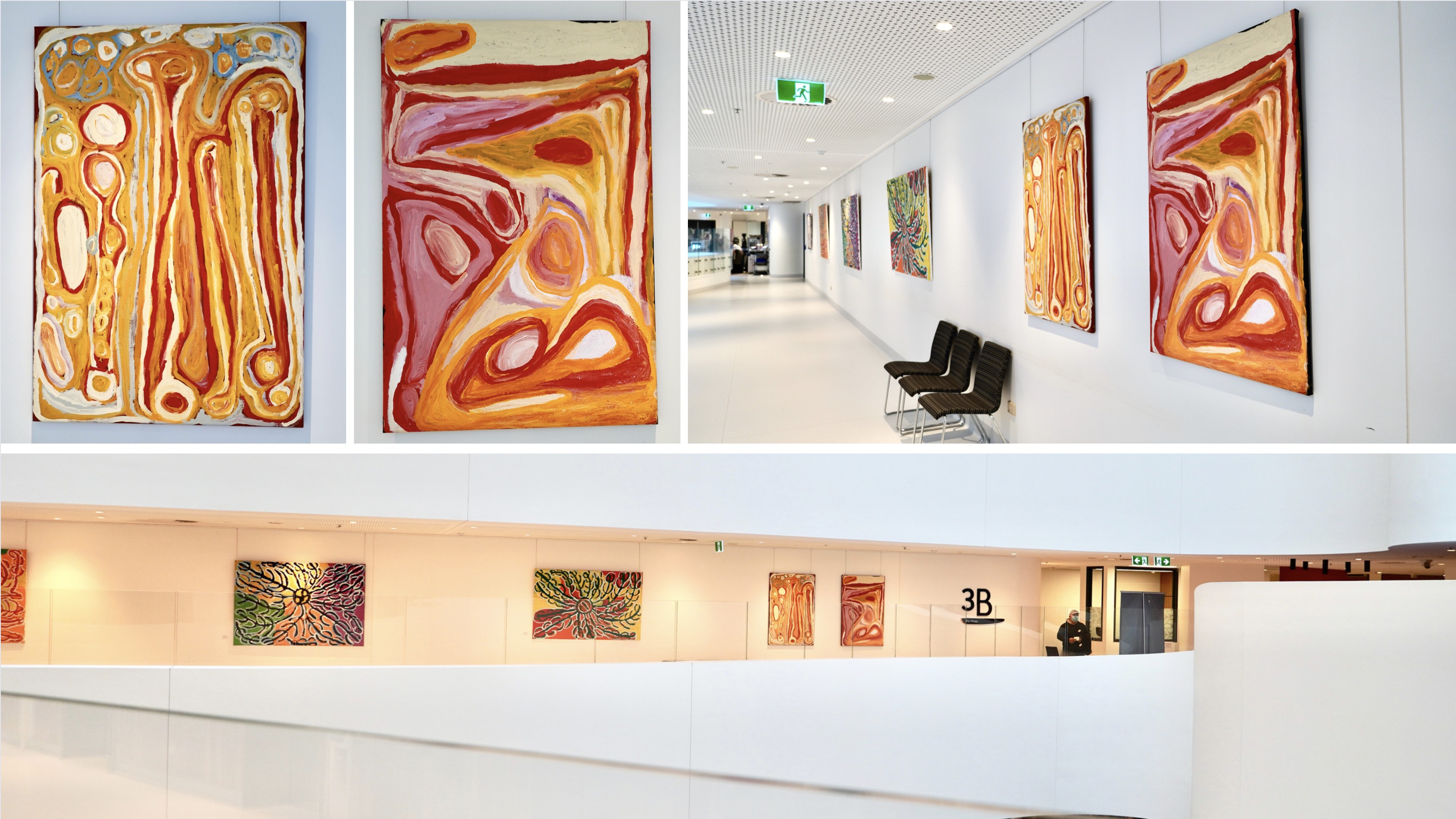
Kunawarritji (2011) by Nora Wompi
Liburu (2011) Nora Nganapa
Location: Level three near clinic 3B
Connection to the land and cultural stories embedded within the landscape is central to the work of Aboriginal artists Nora Wompi and Nora Nganapa. These two women who shared a grandfather were connected by skin, country and circumstance and their art and lives were intrinsically entwined. Sharing a history shaped by the intrusion of the Canning Stock Route on their traditional lands and way of life, they were from the generation of Aboriginal people in the Kimberley who grew up in the desert and came to old Balgo mission with their families seeking refuge. Nomadic life was harsh and even more so during the prolonged and severe drought in the western desert during the 1960s.
Both Wompi and Nganapa painted their traditional country near Kunawarritji, ( Well 33) along the middle stretches of the Canning Stock Route. Their fluid brushstrokes capture dreaming sites, talis (sandhills), soak holes and bush tucker, creating works that reflect their intimate knowledge and spiritual connection to their country, bringing the Great Sandy Desert alive in their art. For many years the two women painted alongside each other.
In Wompi’s Kunawarritji, 2013, sensuous linear elements in the painting represent the tali that dominate this country and are delineated with multiple thick lines. The circular shapes which are rendered with circles of colour, represent rock or soak holes, important sources of water dotted throughout the desert where bush foods including bush tomato and bush raisins are abundant.
Nora Nganapa’s works are highly contemplative and her deliberate application of strokes of colour in a restricted palette are applied with measured assurance. The strong shapes of yellow, red, ochre and green capture the features and stories of Kunawarritji in this painting, Liburu, 2013. Here the central circle represents a significant rock hole, Liburu, near where the artist was born, while the painting tells the story of two snakes who were living in the rock hole and about their journey as they travelled through the sandhills of this region. The linear elements refer to the journey and trees growing in the area.
Donated through the Australian Government’s Cultural Gifts Program in memory of Patricia Anne Bevan.

Mimih Spirits (2001/2002) by Crusoe Kurdall, Timothy Wulanjibirr and Melba Gunjarrwanga
Location: Ground floor, near the research lifts
Three sculptures from the Peter Mac Art Collection, created by significant indigenous artists Crusoe Kurdall, Timothy Wulnjibirr and Melba Gunjarrwanga, working in Maningrida in central Arnhem Land.
They portray a sculptural representation of the mythological Mimih Spirits and have been carved and painted in natural ochres, featuring delicate cross hatching known as raark, ceremonial body designs and scarification marks.
Indigenous people believe that Mimih Spirits live in a social organisation similar to theirs, which however predated their own. They credit them with teaching their ancestors how to survive. While the Mimihs are generally thought to be benign toward humans, sometimes they are attributed with mischievous and dangerous qualities as well.
It is said that Mimihs are shy and flee when approached by strangers, blowing on rocks which open and allow them to seek shelter. As Mimihs are extremely slender and tall, it is thought that strong winds can damage their bodies and therefore, they prefer to emerge on windless nights.
Indigenous people also believe that some tribal magicians or ‘clever men” can develop intimate relationships with Mimih Spirits who then initiate them into the secret knowledge of ritual songs and dances, also revealing the location of sacred places.
Donated through the Australian Government’s Cultural Gifts Program by Gabrielle Pizzi.
